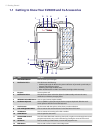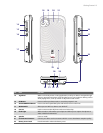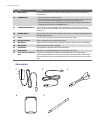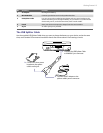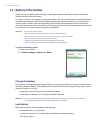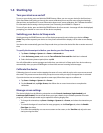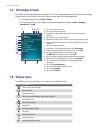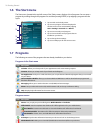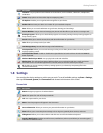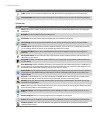Getting Started 17
1.3 Starting Up
Turn your device on and off
To turn on your device, press and hold the POWER button. When you turn on your device for the first time, a
Quick Start Wizard will guide you through the screen calibration process and the setup of regional settings,
date and time, and password. For more information about touch screen calibration, see “Calibrate the device”.
For information about setting a device password, see “Protecting Your XV6800” in Chapter 4.
To turn off your device, press and hold the POWER button for a few seconds. A message will then be displayed,
prompting you whether or not to turn off the device completely.
Switching your device to Sleep mode
Quickly pressing the POWER button turns off the display temporarily and switches your device to Sleep
mode. Sleep mode suspends your device to a low power state while the display is off in order to save battery
power.
Your device also automatically goes into Sleep mode when you leave the device idle after a certain amount of
time.
To specify the timeout period before your device goes into Sleep mode
1. Tap Start > Settings > System tab > Power > Advanced tab.
2. Under On battery power, make sure the Turn off device if not used for check box is selected.
3. Select the battery timeout period, then tap OK.
You will still be able to receive messages and calls when your device is in Sleep mode. Your device wakes up
automatically when you press POWER again or when there are new incoming calls/messages.
Calibrate the device
Calibrating the touch screen involves tapping the center of a cross with the stylus as the cross moves around
the screen. This process ensures that when you tap the screen with your stylus, the tapped item is activated.
If your device does not accurately respond to screen taps, follow these steps to re-calibrate it:
1. Tap Start > Settings > System tab > Screen.
2. On the General tab, tap Align Screen, then follow the on-screen instructions to complete the
calibration.
Manage screen settings
The device’s display has the following orientation modes: Portrait, Landscape (right-handed), and
Landscape (left-handed). Portrait mode allows you to get a better view or a better operation of certain
programs, while Landscape mode may be optimal for viewing lengthy files.
• To change the orientation, tap Start > Settings > System tab > Screen, and select the orientation you
want.
• To smooth the edges of screen fonts for many programs, on the ClearType tab, select the Enable
ClearType check box.
• To increase the readability or to see more content on the screen, on the Text Size tab, adjust the text
size by moving the slider.






